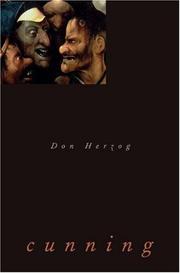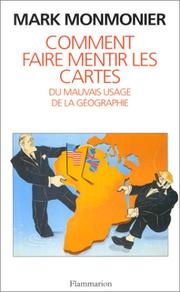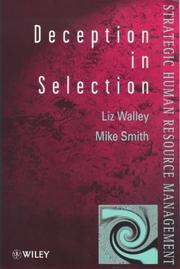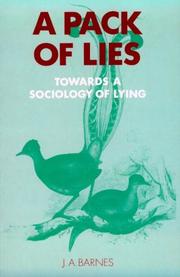| Listing 1 - 9 of 9 |
Sort by
|

ISBN: 0691124159 0691136343 9786612157202 1282157205 140082706X 9781400827060 9780691136349 9780691124155 9780691136349 9781282157200 Year: 2006 Publisher: Princeton : Princeton University Press,
Abstract | Keywords | Export | Availability | Bookmark
 Loading...
Loading...Choose an application
- Reference Manager
- EndNote
- RefWorks (Direct export to RefWorks)
Want to be cunning? You might wish you were more clever, more flexible, able to cut a few corners without getting caught, to dive now and again into iniquity and surface clutching a prize. You might want to roll your eyes at those slaves of duty who play by the rules. Or you might think there's something sleazy about that stance, even if it does seem to pay off. Does that make you a chump? With pointedly mischievous prose, Don Herzog explores what's alluring and what's revolting in cunning. He draws on a colorful range of sources: tales of Odysseus; texts from Machiavelli; pamphlets from early modern England; salesmen's newsletters; Christian apologetics; plays; sermons; philosophical treatises; detective novels; famous, infamous, and obscure historical cases; and more. The book is in three parts, bookended by two murderous churchmen. "Dilemmas" explores some canonical moments of cunning and introduces the distinction between knaves and fools as a "time-honored but radically deficient scheme." "Appearances" assails conventional approaches to unmasking. Surveying ignorance and self-deception, "Despair?" deepens the case that we ought to be cunning--and then sees what we might say in response. Throughout this beguiling book, Herzog refines our sense of what's troubling in this terrain. He shows that rationality, social roles, and morality are tangled together--and trickier than we thought.
Bedriegerij --- Bedrog --- Chicanery --- Deceit --- Deception --- Listen --- Misleiding --- Ruses --- Subterfuge --- Tromperie --- Deception. --- Truthfulness and falsehood --- Intrigue

ISBN: 2082115577 9782082115575 Year: 1993 Publisher: Paris: Flammarion,
Abstract | Keywords | Export | Availability | Bookmark
 Loading...
Loading...Choose an application
- Reference Manager
- EndNote
- RefWorks (Direct export to RefWorks)
Bedriegerij --- Bedrog --- Cartografie --- Cartographie --- Cartography --- Cartography [Primitive ] --- Chartography --- Chicanery --- Deceit --- Deception --- Listen --- Mapping (Cartography) --- Misleiding --- Ruses --- Subterfuge --- Tromperie --- Maps --- Cartes --- Analysis --- Analyse --- Cartographie. --- Tromperie. --- Cartes geographiques

ISBN: 0471974986 9780471974987 Year: 1998 Volume: *1 Publisher: Chichester: Wiley,
Abstract | Keywords | Export | Availability | Bookmark
 Loading...
Loading...Choose an application
- Reference Manager
- EndNote
- RefWorks (Direct export to RefWorks)
Bedriegerij --- Bedrog --- Chicanery --- Deceit --- Deception --- Doorlichting van personeel --- Employee screening --- Employee selection --- Employees Hiring --- Employees [Selection of ] --- Listen --- Misleiding --- Personeel--Doorlichting --- Personeelsselectie --- Personnel--Dépistage --- Ruses --- Selecteren van personeel --- Subterfuge --- Sélection du personnel --- Tromperie --- Employee screening.

ISBN: 0521459788 0521453763 9780521459785 0511520980 9780511520983 9780521453769 Year: 2003 Volume: *7 Publisher: Cambridge: Cambridge university press,
Abstract | Keywords | Export | Availability | Bookmark
 Loading...
Loading...Choose an application
- Reference Manager
- EndNote
- RefWorks (Direct export to RefWorks)
Defining lies as statements that are intended to deceive, this book considers the contexts in which people tell lies, how they are detected and sometimes exposed, and the consequences for the liars themselves, their dupes, and the wider society. The author provides examples from a number of cultures with distinctive religious and ethical traditions, and delineates domains where lying is the norm, domains that are ambiguous and the one domain (science) that requires truthtelling. He refers to experimental studies on children that show how, at an early age, they acquire the capactiy to lie and learn when it is appropriate to do so. He reviews how lying has been evaluated by moralists, examines why we do not regard novels as lies and relates the human capacity to lie to deceit among other animal species. He concludes that although there are, in all societies, good pragmatic reasons for not lying all the time, there are also strong reasons for lying some of the time.
Bedriegerij --- Bedrog --- Chicanery --- Credibilite --- Credibility --- Deceit --- Deception --- Falsehood --- Geloofwaardigheid --- Insincerite --- Leugen --- Listen --- Lying --- Mensonge --- Misleiding --- Onoprechtheid --- Ruses --- Subterfuge --- Tromperie --- Truthfulness and falsehood --- Untruthfulness --- Vérité et mensonge --- Waarheid en leugen --- Deception. --- Truthfulness and falsehood. --- 800:159 --- #SBIB:309H517 --- Psycholinguistiek. Neurolinguistiek --- Verbale communicatie: sociale psychologie van de taal en de interactie, psycholinguistiek --- 800:159 Psycholinguistiek. Neurolinguistiek --- Believability --- Reliability --- Truth --- Honesty --- Intrigue --- Social aspects --- Post-truth --- Social Sciences --- Sociology
Book
ISBN: 9781409205241 Year: 2005 Publisher: Queensland Jasmuheen / La S.E.A. (Self Empowerment Academy)
Abstract | Keywords | Export | Availability | Bookmark
 Loading...
Loading...Choose an application
- Reference Manager
- EndNote
- RefWorks (Direct export to RefWorks)
la guérison Harmonieuse --- visions et information --- mourir avec dignité --- la passion et le positivisme --- la complexité des cures --- synchronismes sacrés --- Transformation de l'Enjeu --- la voie des immortels --- la foi et la détermination --- la médecine magique de la maîtrise de l'esprit et de la méditation --- maladies --- la puissance des émotions --- le bien être émotionne --- la magie de l'esprit --- la revitalisation du système --- reprogrammer la santé --- la magie du style de vie --- l'aide de la guérison par l'harmonie --- outils de reéquilibrage --- l'appareil LISTEN --- la bio résonance --- la kinésiologie --- l'analyse de sang vivant --- Haemaview --- la cinétique holographique --- la Radionique --- Cansema Black Salve --- la Ganothérapie --- le GenMed --- M.W.O. --- les appareils à résistance électromagnétique --- la Plasmonique --- la Nanotechnologie Plasmonique --- la thérapie à l'oxygène --- la chimiothérapie --- les cellules souches --- historique de Jasmuheen
Book
ISBN: 0691231052 Year: 2021 Publisher: Princeton ; Oxford : Princeton University Press,
Abstract | Keywords | Export | Availability | Bookmark
 Loading...
Loading...Choose an application
- Reference Manager
- EndNote
- RefWorks (Direct export to RefWorks)
A provocative and inspiring look at the future of humanity and science from world-renowned scientist and bestselling author Martin ReesHumanity has reached a critical moment. Our world is unsettled and rapidly changing, and we face existential risks over the next century. Various outcomes-good and bad-are possible. Yet our approach to the future is characterized by short-term thinking, polarizing debates, alarmist rhetoric, and pessimism. In this short, exhilarating book, renowned scientist and bestselling author Martin Rees argues that humanity's prospects depend on our taking a very different approach to planning for tomorrow.The future of humanity is bound to the future of science and hinges on how successfully we harness technological advances to address our challenges. If we are to use science to solve our problems while avoiding its dystopian risks, we must think rationally, globally, collectively, and optimistically about the long term. Advances in biotechnology, cybertechnology, robotics, and artificial intelligence-if pursued and applied wisely-could empower us to boost the developing and developed world and overcome the threats humanity faces on Earth, from climate change to nuclear war. At the same time, further advances in space science will allow humans to explore the solar system and beyond with robots and AI. But there is no "Plan B" for Earth-no viable alternative within reach if we do not care for our home planet.Rich with fascinating insights into cutting-edge science and technology, this accessible book will captivate anyone who wants to understand the critical issues that will define the future of humanity on Earth and beyond.
Technology --- Science --- Social aspects. --- Social aspects. --- Adaptation to global warming. --- Andrei Linde. --- Anthropocene. --- Astronomer. --- Astronomy. --- Biotechnology. --- Blue Origin. --- Boston Dynamics. --- Breakthrough Listen. --- Breeder reactor. --- Calculation. --- Carbon. --- Carl Sagan. --- Climate change. --- Climate sensitivity. --- Credential. --- Cryonics. --- David Deutsch. --- Didier Queloz. --- Disaster. --- Dystopia. --- E. O. Wilson. --- Edward Teller. --- Electric charge. --- Elon Musk. --- Eugene Wigner. --- Eugenics. --- Exoplanet. --- Extended family. --- Externality. --- Extraterrestrial life. --- Fossil fuel. --- Frank Drake. --- Frank Wilczek. --- Frequency allocation. --- Fruition. --- Fuel. --- Fusion power. --- Future Evolution. --- Gene. --- Geologist. --- Golden rice. --- Great Leap Forward. --- Handbook. --- Hans Bethe. --- Human spaceflight. --- Hyperloop. --- Impact event. --- Instance (computer science). --- Intelligence explosion. --- Interstellar travel. --- John F. Kennedy. --- Joseph Rotblat. --- Life extension. --- Ludwig Wittgenstein. --- Lunar south pole. --- National Ignition Facility. --- Nobel Prize. --- Normal science. --- Nuclear power. --- Nuclear warfare. --- Nuclear weapon. --- Nuclear winter. --- One-child policy. --- Our Final Hour. --- Pale Blue Dot (book). --- Paul Dirac. --- Perplexity. --- Pfizer. --- Physicist. --- Pigment. --- Political agenda. --- Probability. --- Project Orion (nuclear propulsion). --- Radio telescope. --- Real Humans. --- Retirement age. --- Science. --- Scientist. --- Search for extraterrestrial intelligence. --- Second language. --- Self-interest. --- Solar cell. --- SpaceX. --- Spacecraft. --- Stuxnet. --- Technology. --- Test pilot. --- The Better Angels of Our Nature. --- The Philosopher. --- The Population Bomb. --- The Skeptical Environmentalist. --- Theoretical physics. --- Thought. --- Vasili Arkhipov. --- Vulnerability. --- Warfare. --- Waste heat. --- Year. --- Yuri Milner.
Book
ISBN: 3319551884 3319551876 Year: 2017 Publisher: Cham : Springer International Publishing : Imprint: Palgrave Macmillan,
Abstract | Keywords | Export | Availability | Bookmark
 Loading...
Loading...Choose an application
- Reference Manager
- EndNote
- RefWorks (Direct export to RefWorks)
This book offers a new approach to film studies by showing how our brains use our interpretations of various other films in order to understand Alfred Hitchcock’s Vertigo. Borrowing from behavioral psychology, cognitive science and philosophy, author Robert J. Belton seeks to explain differences of critical opinion as inevitable. The book begins by introducing the hermeneutic spiral, a cognitive processing model that categorizes responses to Vertigo’s meaning, ranging from wide consensus to wild speculations of critical “outliers.” Belton then provides an overview of the film, arguing that different interpreters literally see and attend to different things. The fourth chapter builds on this conclusion, arguing that because people see different things, one can force the production of new meanings by deliberately drawing attention to unusual comparisons. The latter chapters outline a number of such comparisons—including avant-garde films and the works of Stanley Kubrick and David Lynch—to shed new light on the meanings of Vertigo.
Hitchcock, Alfred, --- Hitchcock, Alfred Joseph, --- Hsi-chʻü-kʻao-kʻo, --- Chitskok, Alphrent, --- היצ'קוק, אלפרד, --- Hīchakāk, Al-Frad , --- هيچکاک، الفرد، --- Vertigo (Motion picture : 1958) --- Alfred Hitchcock's Vertigo (Motion picture : 1958) --- Aldowar (Motion picture : 1958) --- Amețeala (Motion picture : 1958) --- Aus dem Reich der Toten (Motion picture : 1958) --- Corpo que cai (Motion picture : 1958) --- Darkling I listen (Motion picture : 1958) --- De entre los muertos (Motion picture : 1958) --- Desmōtēs tou ilingou (Motion picture : 1958) --- Desmotis tou iliggou (Motion picture : 1958) --- Donna che visse due volte (Motion picture : 1958) --- Fear and trembling (Motion picture : 1958) --- From among the dead (Motion picture : 1958) --- Golovokruzhenie (Motion picture : 1958) --- Hyeonghijeung (Motion picture : 1958) --- Illicit darkening (Motion picture : 1958) --- Kvinde skygges (Motion picture : 1958) --- Memai (Motion picture : 1958) --- Mulher que viveu duas vezes (Motion picture : 1958) --- Navazhdenie (Motion picture : 1958) --- Ölüm Korkusu (Motion picture : 1958) --- Punainen kyynel (Motion picture : 1958) --- Röd tår (Motion picture : 1958) --- Sargije (Motion picture : 1958) --- Shemet (Motion picture : 1958) --- Studie i brott (Motion picture : 1958) --- Svaigulys (Motion picture : 1958) --- Sueurs froides (Motion picture : 1958) --- Szédülés (Motion picture : 1958) --- Vertigen (Motion picture : 1958) --- Vrouw die tweemaal leefde (Motion picture : 1958) --- Vrtoglavica (Motion picture : 1958) --- Zapamorochenni︠a︡ (Motion picture : 1958) --- Zawrót glowy (Motion picture : 1958) --- Zij die tweemal leefde (Motion picture : 1958) --- Шемет (Motion picture : 1958) --- Наваждение (Motion picture : 1958) --- Головокружение (Motion picture : 1958) --- Запаморочення (Motion picture : 1958) --- Δεσμώτης του ιλίγγου (Motion picture : 1958) --- Motion pictures-History. --- Motion pictures. --- Hermeneutics. --- Aesthetics. --- Consciousness. --- Film History. --- Film Theory. --- Audio-Visual Culture. --- Cognitive Psychology. --- Apperception --- Mind and body --- Perception --- Philosophy --- Psychology --- Spirit --- Self --- Beautiful, The --- Beauty --- Esthetics --- Taste (Aesthetics) --- Art --- Criticism --- Literature --- Proportion --- Symmetry --- Interpretation, Methodology of --- Cinema --- Feature films --- Films --- Movies --- Moving-pictures --- Audio-visual materials --- Mass media --- Performing arts --- History and criticism --- Motion pictures—History. --- Cognitive psychology. --- Psychology, Cognitive --- Cognitive science --- Radio broadcasting Aesthetics --- Aesthetics
Book
ISBN: 9781844574988 1844574989 Year: 2012 Publisher: London ; New York : British film institute Palgrave Macmillan,
Abstract | Keywords | Export | Availability | Bookmark
 Loading...
Loading...Choose an application
- Reference Manager
- EndNote
- RefWorks (Direct export to RefWorks)
Vertigo (1958) is widely regarded as not only one of Hitchcock's best films, but one of the greatest films of world cinema. Made at the time when the old studio system was breaking up, it functions both as an embodiment of the supremely seductive visual pleasures that 'classical Hollywood' could offer and - with the help of an elaborate plot twist - as a laying bare of their dangerous dark side. The film's core is a study in romantic obsession, as James Stewart's Scottie pursues Madeleine/Judy (Kim Novak) to her death in a remote Californian mission. Novak is ice cool but vulnerable, Stewart - in the darkest role of his career - genial on the surface but damaged within. Although it can be seen as Hitchcock's most personal film, Charles Barr argues that, like Citizen Kane, Vertigo is at the same time a triumph not so much of individual authorship as of creative collaboration. He highlights the crucial role of screenwriters Alec Coppel and Samuel Taylor and, by a combination of textual and contextual analysis, explores the reasons why Vertigo continues to inspire such fascination. In his foreword to this special edition, published to celebrate the 20th anniversary of the BFI Film Classics series, Barr looks afresh at Vertigo alongside the recently-rediscovered 'lost' silent The White Shadow (1924), scripted by Hitchcock, which also features the trope of the double, and at the acclaimed contemporary silent film The Artist (2011), which pays explicit homage to Vertigo in its soundtrack.
Hitchcock, Alfred, --- Critique et interprétation --- Vertigo (film) --- Vertigo (Motion picture : 1958) --- Alfred Hitchcock's Vertigo (Motion picture) --- #SBIB:309H1320 --- #SBIB:309H1321 --- De filmische boodschap: algemene werken (met inbegrip van algemeen filmhistorische werken en filmhistorische werken per land) --- Films met een amusementsfunctie en/of esthetische functie: algemeen --- Alfred Hitchcock's Vertigo (Motion picture : 1958) --- Aldowar (Motion picture : 1958) --- Amețeala (Motion picture : 1958) --- Aus dem Reich der Toten (Motion picture : 1958) --- Corpo que cai (Motion picture : 1958) --- Darkling I listen (Motion picture : 1958) --- De entre los muertos (Motion picture : 1958) --- Desmōtēs tou ilingou (Motion picture : 1958) --- Desmotis tou iliggou (Motion picture : 1958) --- Donna che visse due volte (Motion picture : 1958) --- Fear and trembling (Motion picture : 1958) --- From among the dead (Motion picture : 1958) --- Golovokruzhenie (Motion picture : 1958) --- Hyeonghijeung (Motion picture : 1958) --- Illicit darkening (Motion picture : 1958) --- Kvinde skygges (Motion picture : 1958) --- Memai (Motion picture : 1958) --- Mulher que viveu duas vezes (Motion picture : 1958) --- Navazhdenie (Motion picture : 1958) --- Ölüm Korkusu (Motion picture : 1958) --- Punainen kyynel (Motion picture : 1958) --- Röd tår (Motion picture : 1958) --- Sargije (Motion picture : 1958) --- Shemet (Motion picture : 1958) --- Studie i brott (Motion picture : 1958) --- Svaigulys (Motion picture : 1958) --- Sueurs froides (Motion picture : 1958) --- Szédülés (Motion picture : 1958) --- Vertigen (Motion picture : 1958) --- Vrouw die tweemaal leefde (Motion picture : 1958) --- Vrtoglavica (Motion picture : 1958) --- Zapamorochenni︠a︡ (Motion picture : 1958) --- Zawrót glowy (Motion picture : 1958) --- Zij die tweemal leefde (Motion picture : 1958) --- Шемет (Motion picture : 1958) --- Наваждение (Motion picture : 1958) --- Головокружение (Motion picture : 1958) --- Запаморочення (Motion picture : 1958) --- Δεσμώτης του ιλίγγου (Motion picture : 1958) --- Hitchcock, Alfred --- Critique et interprétation. --- Vertigo (Motion picture : 1958).
Book
ISBN: 9780861967421 0861967429 Year: 2021 Publisher: New Barnet, UK : JL.
Abstract | Keywords | Export | Availability | Bookmark
 Loading...
Loading...Choose an application
- Reference Manager
- EndNote
- RefWorks (Direct export to RefWorks)
When Richard Schickel stated unequivocally in 1972 that "We're living in a Hitchcock world, all right", he did so without even mentioning the film that now stands at the top of the Sight & Sound Greatest Films of All Time poll: Vertigo. That omission needs to be redressed when we think about the Hitchcock world we live in now. Haunted by Vertigo: Hitchcock's Masterpiece Then and Now gathers essays that offer a variety of approaches to what many consider to be Hitchcock's signature film, one that shows him operating at full strength as a cinematic artist portraying some of the defining elements of modern life: romantic exhilaration and anxiety, the attractiveness and elusiveness of love, and the interpenetration of pain, pleasure, life, and death in our psyche and our culture.The pieces in this volume explore numerous aspects of how, broadly speaking, Vertigo is about characters haunted by memories and desires; how the film itself is haunted by numerous literary and cinematic fore- bearers; and how it continues to haunt not only filmmakers but artists working in other media as well. Essays that concentrate on formative or interpretive contexts of the film, including Greek mythology, early German cinema, film noir, an ensemble of (mostly) French writers and filmmakers, andmodern and postmodern art are complemented by others that present close readings of hidden details in the film, its use of multiple gazes that underscore its meaning and drama, the darker sides of even gestures of love and hospitality, and how the film embodies Hitchcock's "late style". Taken together the essays in the volume reinforce how Vertigo is, like the majestic trees visited by the two main characters in the film, sempervirens – an enduring masterpiece of then, now, and, we can safely say, the future.RE
film --- filmgeschiedenis --- filmanalyse --- filmtheorie --- filmregisseurs --- Verenigde Staten --- Groot-Brittannië --- twintigste eeuw --- Hitchcock Alfred --- 791.471 HITCHCOCK --- Hitchcock, Alfred, --- Hitchcok, Alfred --- Chitskok, Alphrent, --- Hīchakāk, Al-Frad , --- Hitchcock, Alfred Joseph, --- Hsi-chʻü-kʻao-kʻo, --- היצ'קוק, אלפרד, --- هيچکاک، الفرد، --- Criticism and interpretation. --- Vertigo (Motion picture : 1958) --- Alfred Hitchcock's Vertigo (Motion picture : 1958) --- Aldowar (Motion picture : 1958) --- Amețeala (Motion picture : 1958) --- Aus dem Reich der Toten (Motion picture : 1958) --- Corpo que cai (Motion picture : 1958) --- Darkling I listen (Motion picture : 1958) --- De entre los muertos (Motion picture : 1958) --- Desmōtēs tou ilingou (Motion picture : 1958) --- Desmotis tou iliggou (Motion picture : 1958) --- Donna che visse due volte (Motion picture : 1958) --- Fear and trembling (Motion picture : 1958) --- From among the dead (Motion picture : 1958) --- Golovokruzhenie (Motion picture : 1958) --- Hyeonghijeung (Motion picture : 1958) --- Illicit darkening (Motion picture : 1958) --- Kvinde skygges (Motion picture : 1958) --- Memai (Motion picture : 1958) --- Mulher que viveu duas vezes (Motion picture : 1958) --- Navazhdenie (Motion picture : 1958) --- Ölüm Korkusu (Motion picture : 1958) --- Punainen kyynel (Motion picture : 1958) --- Röd tår (Motion picture : 1958) --- Sargije (Motion picture : 1958) --- Shemet (Motion picture : 1958) --- Studie i brott (Motion picture : 1958) --- Svaigulys (Motion picture : 1958) --- Sueurs froides (Motion picture : 1958) --- Szédülés (Motion picture : 1958) --- Vertigen (Motion picture : 1958) --- Vrouw die tweemaal leefde (Motion picture : 1958) --- Vrtoglavica (Motion picture : 1958) --- Zapamorochenni︠a︡ (Motion picture : 1958) --- Zawrót glowy (Motion picture : 1958) --- Zij die tweemal leefde (Motion picture : 1958) --- Шемет (Motion picture : 1958) --- Наваждение (Motion picture : 1958) --- Головокружение (Motion picture : 1958) --- Запаморочення (Motion picture : 1958) --- Δεσμώτης του ιλίγγου (Motion picture : 1958) --- Criticism and interpretation --- Vertigo
| Listing 1 - 9 of 9 |
Sort by
|

 Search
Search Feedback
Feedback About UniCat
About UniCat  Help
Help News
News